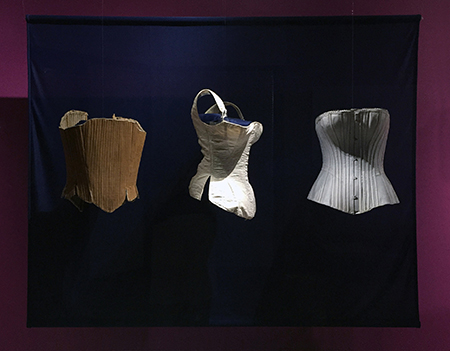Dr. Anne Bissonnette, Larisa Cheladyn, Stephanie Huolt, Robyn Stobbs
and Sarah Woodyard exhibition co-curators
April 9, 2015, to February 19, 2016
Stays & Corsets | Proper Form | Quilted Compositions | The Language of Folk Dress | Fashion Statements | Gallery Views | Artifacts |

*
How might changing silhouettes affect the work of dressmakers? Does technology influence the way clothing is constructed? The different stitches and fashionable ideals seen in these stays and corsets reflect the development of technology and labour changes. Machines were designed to mimic the hand’s capabilities, but failed to leave the same human imprint of versatility and creativity. Support garments provided the foundation from which mantua-makers demonstrated their innovative ability to cut and fit custom garments.
By the 1870s, sewing machines were valued for their speed and used at home and in industry. This technology affected dress with a proliferation of surface trims and embellishments that were much easier and faster to produce. As a result, the dressmaker’s tactile conversation with fabric was overshadowed by automation.
*
Cite this page (bibliography):
Bissonnette, Anne, Larisa Cheladyn, Stephanie Huolt, Robyn Stobbs and Sarah Woodyard. “Stays & Corsets.” Stitched Narratives, Clothing and Textiles Collection Web site, Department of Human Ecology, University of Alberta, July 15, 2015. [INSERT URL].
*
Photograph by Anne Bissonnette©
This exhibition is part of the graduate course “Material Culture & Curatorship” (HECOL 668).
Sponsorship provided by The Kule Institute for Advanced Study and The Bohdan Medwidsky Ukrainian Folklore Archives.
